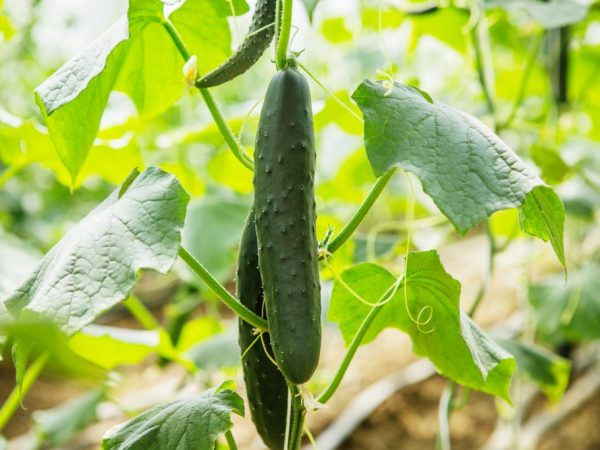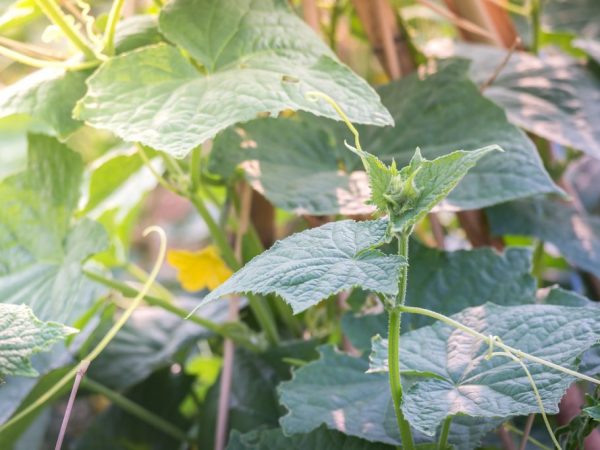How to process cucumbers in a greenhouse
Unfavorable climatic conditions, as well as the desire to get an earlier harvest, force gardeners to grow cucumbers in a greenhouse. However, in such conditions, there is a risk of multiplication of pathogenic bacteria, pathogenic fungi and harmful insects. To prevent this, you need to know how and how to process cucumbers in a greenhouse.

Processing cucumbers in the greenhouse
Rules for processing cucumbers in a greenhouse
It is recommended to process cucumbers in a greenhouse as a preventive measure to increase yields, as well as to fight diseases and pests. For maximum effect, follow these guidelines:
- To cultivate a crop, choose a sunny day.
- Spray cucumbers with vents and doors closed.
- Start processing from the bottom of the sheet.
- An hour after spraying, loosen the topsoil 2 cm thick.
Pests of cucumber beds
Small insects can cause significant damage to vegetable plantings in the greenhouse. Such pests include melon aphids and whiteflies.
Whitefly
Small insects with white wings stick to cucumber leaves. They feed on the sap of the plant. A sticky, sugary discharge forms on the lower part of the leaf plate, which turns into a fungus that infects crops. Gradually, the sprouts turn black and dry out.
As a measure to control whitefly, it is necessary to spray the plants and rinse the underside of the leaves with soapy water. After processing, you need to loosen the soil to a depth of 2 cm. To cultivate the soil under the cucumber sprouts, use sawdust, sand, peat.
Aphid
Colonies of aphid melons settle in flowers, ovaries, cucumber leaves. The leaves curl, the plant does not receive enough nutrients and stops growing.
To control aphids, keep weeds out of your cucumber beds. If there are insects on the plants, spray the culture with soapy water or infusion of bitter red capsicum:
- Prepare a soap solution from 100 gr. shavings of any soap, diluted in 10 liters. water.
- To prepare the pepper infusion, take 200 gr. ash residue and 30 gr. fresh pepper, fill them with a bucket of hot water, leave to infuse for 24 hours. After the solution, strain, add one tablespoon of liquid soap or 25 gr. soap shavings.
We process the plants with the resulting composition. Repeat the processing of cucumber beds several times. Wait seven to ten days between sprays.
For insect control, you can use ready-made insecticides. Among the proposed chemicals, Intra-vir and Strela showed good results. Apply insecticides strictly according to the manufacturer's instructions. Remove the crop from the bushes before processing.
Diseases of cucumber bushes
When growing crops in greenhouses, bushes are exposed to various diseases. Depending on the type of disease, gardeners decide how to process cucumbers in a greenhouse.

The agent for processing must be selected
Diseases of cucumbers can be divided into three groups:
- Fungal diseases are caused by pathogenic fungi that live in garden tools or in the soil. To prevent such diseases, it is imperative to disinfect the soil and tools before planting cucumbers.
- Disease-causing bacteria multiply when agricultural practices are violated. Organize proper plant care to prevent the development of bacterial diseases.
- Viral diseases can be transmitted through contaminated seeds. Before planting the culture, decontaminate the seeds with a pink solution.
Fungal diseases
Among the diseases caused by fungi, the most common are antacnosis, various types of rot, spotting and others. All diseases are manifested in one way or another on the bushes:
- With antacnosis, light brownish spots are formed on the stems and leaf plates. Gradually, rather deep wounds are formed on the fruits, filled with pink clots of mucus. High humidity is a comfortable environment for antacnosis breeding.
- White rot is manifested by the formation of a white bloom on the stems. All plant tissues are softened. As a result, the cucumber bushes rot. Increased humidity accelerates the development of the disease. Annual disinfection of the soil will help reduce the population of this type of fungus.
- Root rot is manifested in a sharp wilting of leaves, drying of cucumber lashes. The progression of the disease leads to the death of the root system.
- Signs of gray rot are rather large blotches of brown color, rotting of the stems. Zelentsy are first covered with brown spots, which are overgrown with a fluffy gray bloom. Mushrooms feel comfortable with a sharp decrease in thermometer readings at night, when irrigated with cold water, and there is no ventilation.
- Peronosporosis begins with yellow spots, which acquire a purple bloom on the lower part of the leaf plate. This disease develops in plantings that receive a large amount of sunshine.
- Olive spot begins to develop when irrigated with cold water, drafts. Small brown sores appear on the cucumbers. Usually, fluid oozes from these wounds. Such fruits are unusable.
With the progression of the disease, damaged shoots are removed. Gardeners treat cucumbers in the greenhouse with special preparations. Among them are Trichodermin, Planriz, Strobi, Quadris. Apply chemicals strictly in accordance with the manufacturer's instructions.
The use of wood ash both in dry form and in the form of solutions demonstrates a good result in the fight against fungal diseases. After the destruction of the infected sprouts, the soil in the beds is sprinkled with ash. For watering or spraying, prepare a solution of 200 gr. ash residue and 1 liter of water.
Viral diseases
The most common viral disease of cucumber bushes is a common mosaic. The first signs of the disease appear with yellow, white spots that appear on young leaves. The plant stops growing, flowering becomes rare, the fruits acquire a variegated color.
The impetus for the development of the disease can serve as sudden changes in temperature. Infected bushes disappear. This will result in crop loss.
Treatment
When a disease is detected, the infected seedlings are destroyed. It is recommended to treat healthy plants with fungicides.
Bacterial diseases of cucumbers
Bacteriosis affects cucumber plantings at any stage of development. This disease can lead to the death of half of the plants. The most comfortable conditions for the development of bacteria are created by a high degree of humidity and a relatively low air temperature.
Bacteriosis affects almost all parts of the plant. The disease can be identified by the characteristic angular brown spots on the leaves. Ulcers appear on the fruits. Zelentsy can be deformed. If bacteria live in seeds, then these seeds will not germinate, but will rot.
Treatment
To prevent the development of bacteriosis, spray the plantings with a solution of Bordeaux liquid.
To grow healthy cucumbers, do not violate the rules of agricultural technology. If the first signs of disease are detected, it is worth immediately treating the crop planting with special preparations. Give a special place in the fight against pests and diseases to preventive measures.

